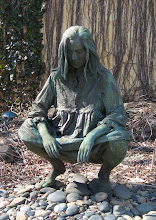“How’d you know what to say?” he asked. The medical students
shadowing me asked this question. Most people regardless of their background or
discipline ask that question. The other common phrase is, “I don’t know how you
can do what you do. I couldn’t”.
“The journey of a thousand miles begins beneath one's feet”,
is from the quote by Chinese philosopher Laozi. Great surgeons don’t start their
career in an operating room. The science of medicine is learned and the art of medicine is a trained gift.
Chaplains
don’t start their work by sitting by the bedside of a patient who is asking, “What do you
say Chaplain, to a person who isn’t sure what they believe and they are going
to die?” They might start with a less ill patient and still let the patient
lead the way.
When I first began hospital visitations.. in my clinical
beginning.. my mentor would have me visit one patient and return to his office
to discuss the case. We would talk for an hour about what the patient said,
what I said, and how I might have participated in that conversation
differently. Many years later I participated in clinical training. C.P.E.
Clinical Pastoral Education is what that stands for. There are training centers
all over the United States and several others through out the world. Each unit
earned in this program consists of 400 supervised clinical hours. That time
estimate doesn’t account for all of the reading, writing and other requirements
for the program.
Students in C.P.E. begin much like I did with my mentor.
Students visit a patient and then write a paper aptly named a verbatim. Indeed NOT
recorded, but to the students best recollection the conversation verbatim. What
did the student see in the room? What was absent? What was said between the
student, patient, staff or any other person in the patient’s room? What was not
said? What is the theological reflection [from the students religious
tradition] of the patient’s situation? Often it is the recollection of the
conversation, what the student HEARD not necessarily what was said that also
reflects the state of mind of the student. When presented to colleagues, always
in a clinical and confidential setting [HIPPA guarded] the student’s colleagues
feed back, as well as their supervisor, places in the verbatim where the
conversation was too directive, missed an important patient cue or possibly
well done.
To apply to become a board certified Chaplain, the applicant
needs to have completed four of these academic units. The requirements for
application to C.P.E. are long as well.
I will share a secret. More of what I have learned is what
not to say rather than what to say. More of what I have learned is not to give
answers but to ask the right questions. MOST of what I have learned has been
gifted to me with the trust from the patients and those who love them.
This was a week that left me brimming with gratitude and
guarded with humility. I saw my work reflected through those medical students’
wide eyes. This week was one of the remarkable weeks that a Chaplain savors for
months on end. It ended as one of the weeks when I will fall asleep with tears
in my eyes knowing in fact I have made someone’s living better and someone’s
dying easier. I am so fortunate to be given the work I do.
Not so much flying by the seat of my pants but focused and
intent on each patient's need. Yes I am clinically trained and have many years
of experience but what I hope more than anything is that each gift of trust
from a patient can be regifted to others. I am deeply grateful to every one.







